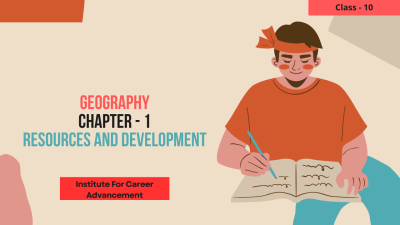Resources and Development - Class 10
Resources and Development is a crucial chapter in Class 10 Geography, focusing on the concept of resources and their significance in human development. It explores the various types of resources, their distribution, and the ways in which they are utilized to improve the quality of life. Key topics covered in this chapter include: Types of Resources: Natural, human, and capital resources. Resource Classification: Renewable and non-renewable resources. Resource Planning: The importance of sustainable resource management. Resource Development: Strategies for effective resource utilization. Development Indicators: Measuring the progress of a nation (e.g., HDI, literacy rate, per capita income). Sustainable Development: Balancing economic growth with environmental protection and social equity. By studying this chapter, students gain a deeper understanding of the world around them, the challenges faced in resource management, and the importance of sustainable practices for a better future. সম্পদ ও উন্নয়ন দশম শ্রেণির ভূগোলের একটি গুরুত্বপূর্ণ অধ্যায়, যা সম্পদের ধারণা এবং মানব উন্নয়নে তাদের গুরুত্বের উপর দৃষ্টি নিবদ্ধ করে। এটি বিভিন্ন ধরনের সম্পদ, সেগুলির বন্টন এবং জীবনযাত্রার মান উন্নত করতে সেগুলির ব্যবহারের উপায়গুলি অনুসন্ধান করে। এই অধ্যায়ে অন্তর্ভুক্ত মূল বিষয়গুলি হলঃ সম্পদের প্রকারঃ প্রাকৃতিক, মানবসম্পদ ও মূলধন। সম্পদ শ্রেণিবিন্যাসঃ পুনর্নবীকরণযোগ্য এবং অ-পুনর্নবীকরণযোগ্য সম্পদ। সম্পদ পরিকল্পনাঃ টেকসই সম্পদ ব্যবস্থাপনার গুরুত্ব। সম্পদ উন্নয়নঃ কার্যকর সম্পদ ব্যবহারের কৌশল। উন্নয়ন সূচকঃ একটি জাতির অগ্রগতির পরিমাপ (e.g., HDI, literacy rate, per capita income). টেকসই উন্নয়নঃ পরিবেশ সুরক্ষা ও সামাজিক সাম্যের সঙ্গে অর্থনৈতিক প্রবৃদ্ধির ভারসাম্য বজায় রাখা। এই অধ্যায়টি অধ্যয়নের মাধ্যমে, শিক্ষার্থীরা তাদের চারপাশের বিশ্ব, সম্পদ ব্যবস্থাপনার ক্ষেত্রে যে চ্যালেঞ্জগুলির মুখোমুখি হয় এবং উন্নত ভবিষ্যতের জন্য টেকসই অনুশীলনের গুরুত্ব সম্পর্কে গভীর ধারণা অর্জন করে।
English
Last updated
Wed, 27-Nov-2024



















